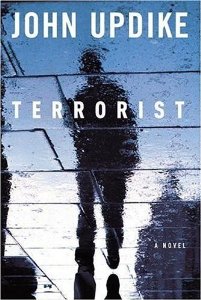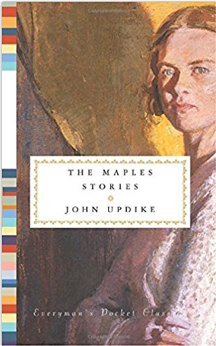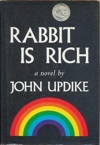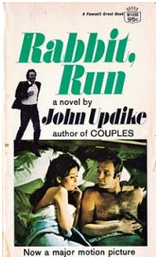Boston radio’s Christopher Lydon has interviewed Updike on numerous occasions, and now he’s turned his admiration for Updike into “Open Source” conversations. In “John Updike and his Terrorist,” Lydon shares an interview he did with Updike about the post-9/11 novel and adds his own comments:
 “Terrorist is cinematic and political—wonderfully so, as I read it. It may be as close to the movie Syriana as we’ll ever get from Updike.
“Terrorist is cinematic and political—wonderfully so, as I read it. It may be as close to the movie Syriana as we’ll ever get from Updike.
“It’s not for me to vouch that he nailed every answer here. But I can report the huge pleasure for one reader—picking up a piece of our conversation recently on The Great American Novel—in ‘public’ fiction, masterfully made, encompassing the depressive high-school guidance counsellor Jack Levy, and the hateful Secretary of Homeland Security, whose name sounds like Haffenreffer; and at the center of it all, Ahmad Ashmawy Mullow at the brink of manhood, flickering between earnestness and extremism, trying to solidify a Muslim consciousness in what feels like a wasteland of selfishness and materialism.'”
On January 28, 2009, one day after Updike died, Lydon had paid tribute to the legendary writer who chose the Boston area for his home for his adult life, in “John Updike: Ted Williams of Our Prose”: “John Updike had every kind of grace about him, including for me an aura of divine blessing. I liked his religious inquiries better than the Rabbit books—novels like A Month of Sundays, Roger’s Version, and In the Beauty of the Lilies, and of course stories like ‘Pigeon Feathers’ about a boy’s crisis of faith, which ends in his famous meditation on the pigeons he’s shot, on orders, in his mother’s barn, and the irresistible beauty of the blue and gray patterns in their dull coloring.”

 British writer Diana Evans has written four acclaimed novels and, more recently, a collection of essays titled
British writer Diana Evans has written four acclaimed novels and, more recently, a collection of essays titled  For this entry we need to thank writer
For this entry we need to thank writer 


 “The third installment of John Updike’s ‘Rabbit’ series finds Harry ‘Rabbit’ Angstrom finally comfortable—or at least financially secure—amid the tumultuous backdrop of 1979’s oil crisis and stagflation. ‘How can you respect the world when you see it’s being run by a bunch of kids turned old?’ the narrator observes, capturing the novel’s eerie contemporary resonance: interest rates and real-estate climbing skyward—and staying there—and a gnawing certainty that the next generation won’t have it quite so good. Updike’s prose transforms the mundane rhythms of middle-class life into something approaching poetry as he excavates middle-class anxiety and success. Rabbit’s car dealership is printing money thanks to the Japanese vehicles he sells, even as his own prejudices and racial anxieties bubble beneath the surface. His son Nelson is adrift, the world seems to be coming apart at the seams and Rabbit’s own biases reflect the tensions of a changing America. The novel won Updike both the Pulitzer Prize and the National Book Award for its devastating precision in capturing what it means to ‘make it’ while watching the ladder get pulled up behind you.”
“The third installment of John Updike’s ‘Rabbit’ series finds Harry ‘Rabbit’ Angstrom finally comfortable—or at least financially secure—amid the tumultuous backdrop of 1979’s oil crisis and stagflation. ‘How can you respect the world when you see it’s being run by a bunch of kids turned old?’ the narrator observes, capturing the novel’s eerie contemporary resonance: interest rates and real-estate climbing skyward—and staying there—and a gnawing certainty that the next generation won’t have it quite so good. Updike’s prose transforms the mundane rhythms of middle-class life into something approaching poetry as he excavates middle-class anxiety and success. Rabbit’s car dealership is printing money thanks to the Japanese vehicles he sells, even as his own prejudices and racial anxieties bubble beneath the surface. His son Nelson is adrift, the world seems to be coming apart at the seams and Rabbit’s own biases reflect the tensions of a changing America. The novel won Updike both the Pulitzer Prize and the National Book Award for its devastating precision in capturing what it means to ‘make it’ while watching the ladder get pulled up behind you.” Thomas wrote, “On a dreary Wednesday in September, 1960, John Updike, ‘falling in love, away from marriage,’ took a taxi to see his paramour. But, he later wrote, she didn’t answer his knock, and so he went to a ballgame at Fenway Park for his last chance to see the Red Sox outfielder Ted Williams, who was about to retire. For a few dollars, he got a seat behind third base.
Thomas wrote, “On a dreary Wednesday in September, 1960, John Updike, ‘falling in love, away from marriage,’ took a taxi to see his paramour. But, he later wrote, she didn’t answer his knock, and so he went to a ballgame at Fenway Park for his last chance to see the Red Sox outfielder Ted Williams, who was about to retire. For a few dollars, he got a seat behind third base. In an
In an 
 Today’s Washington Post featured a Q&A, “Post critic Michael Dirda turns a page: Dirda discusses the life of a critic, and his decision for a change of pace after 30 years of weekly columns,” in which John Updike merited a brief mention.
Today’s Washington Post featured a Q&A, “Post critic Michael Dirda turns a page: Dirda discusses the life of a critic, and his decision for a change of pace after 30 years of weekly columns,” in which John Updike merited a brief mention.